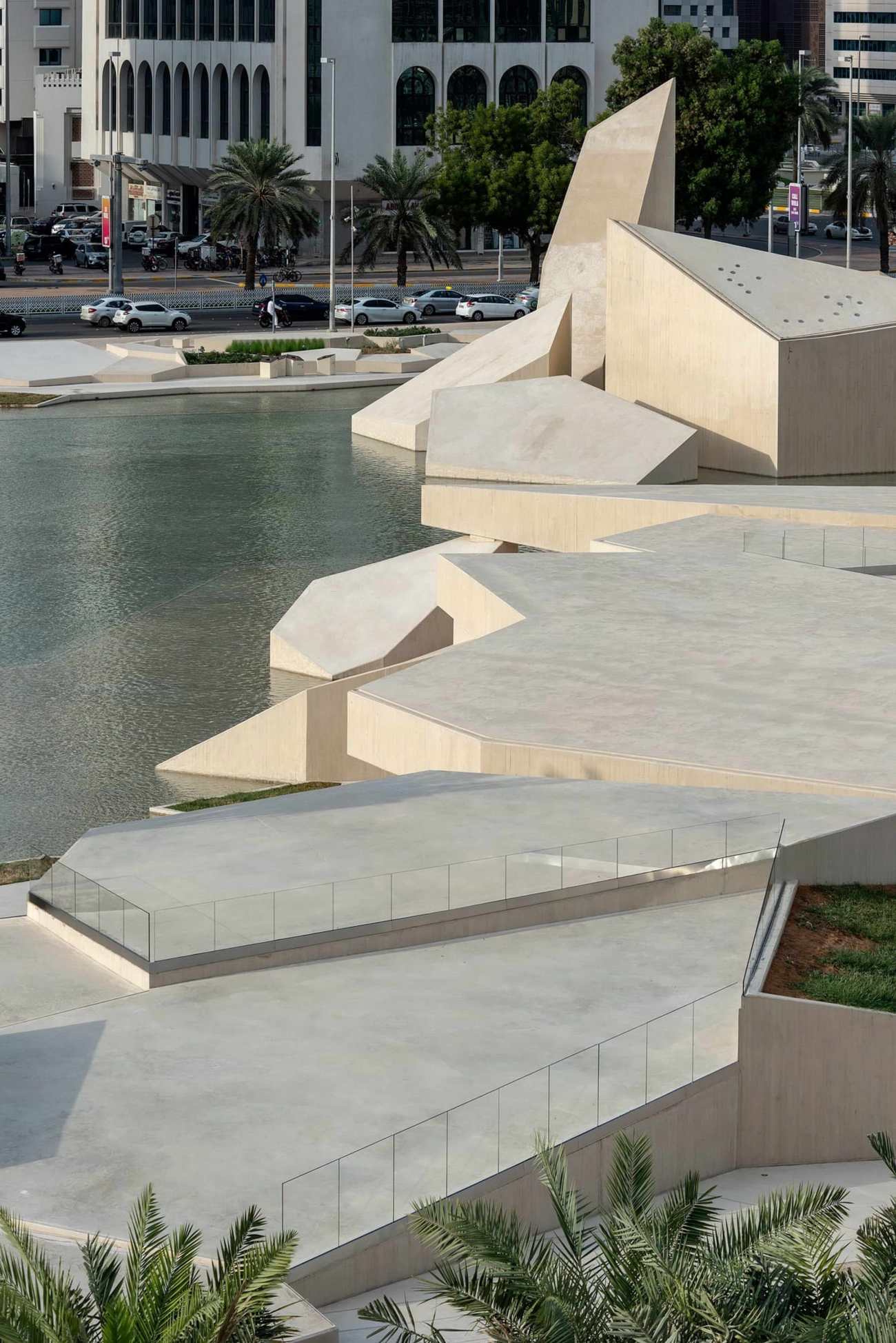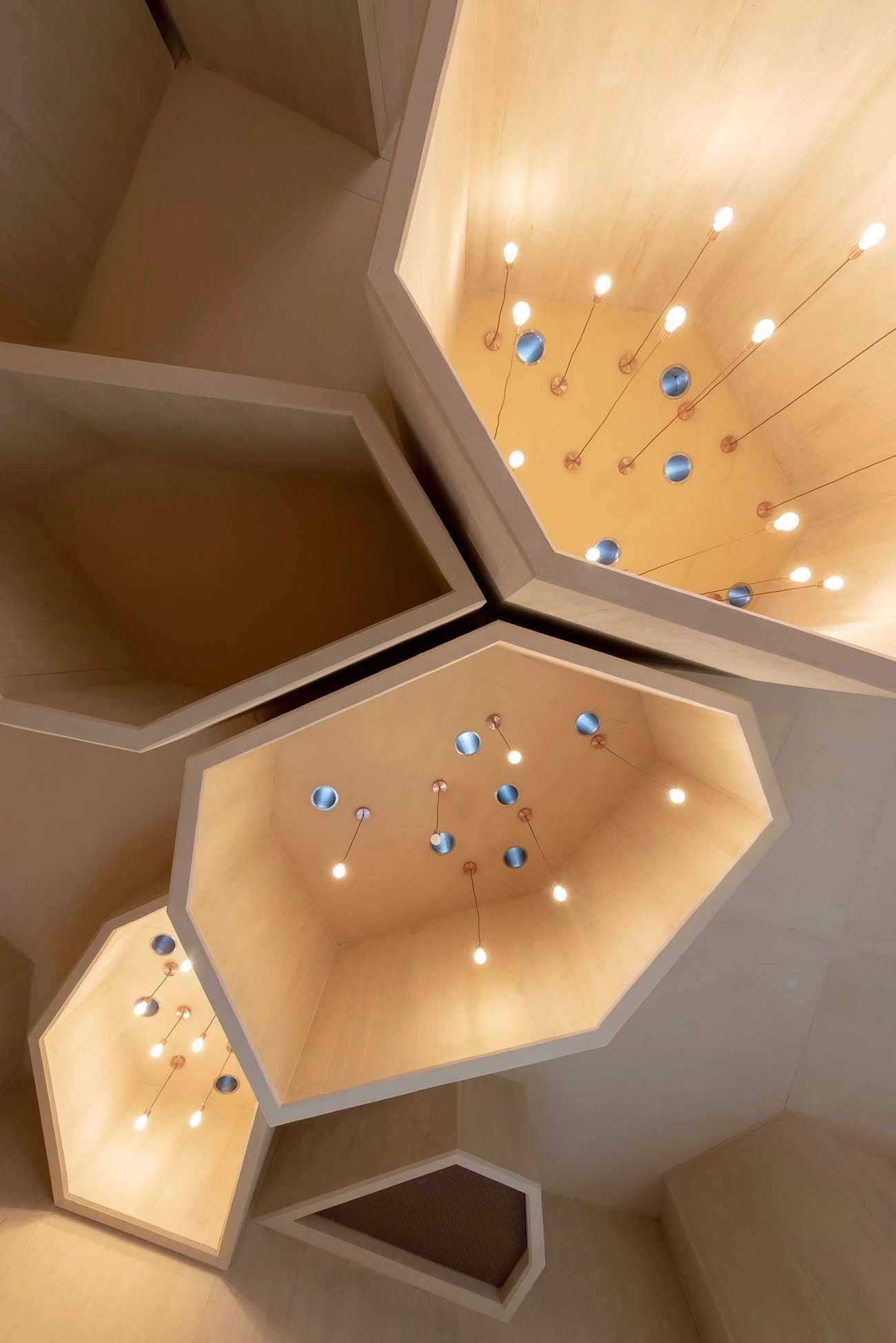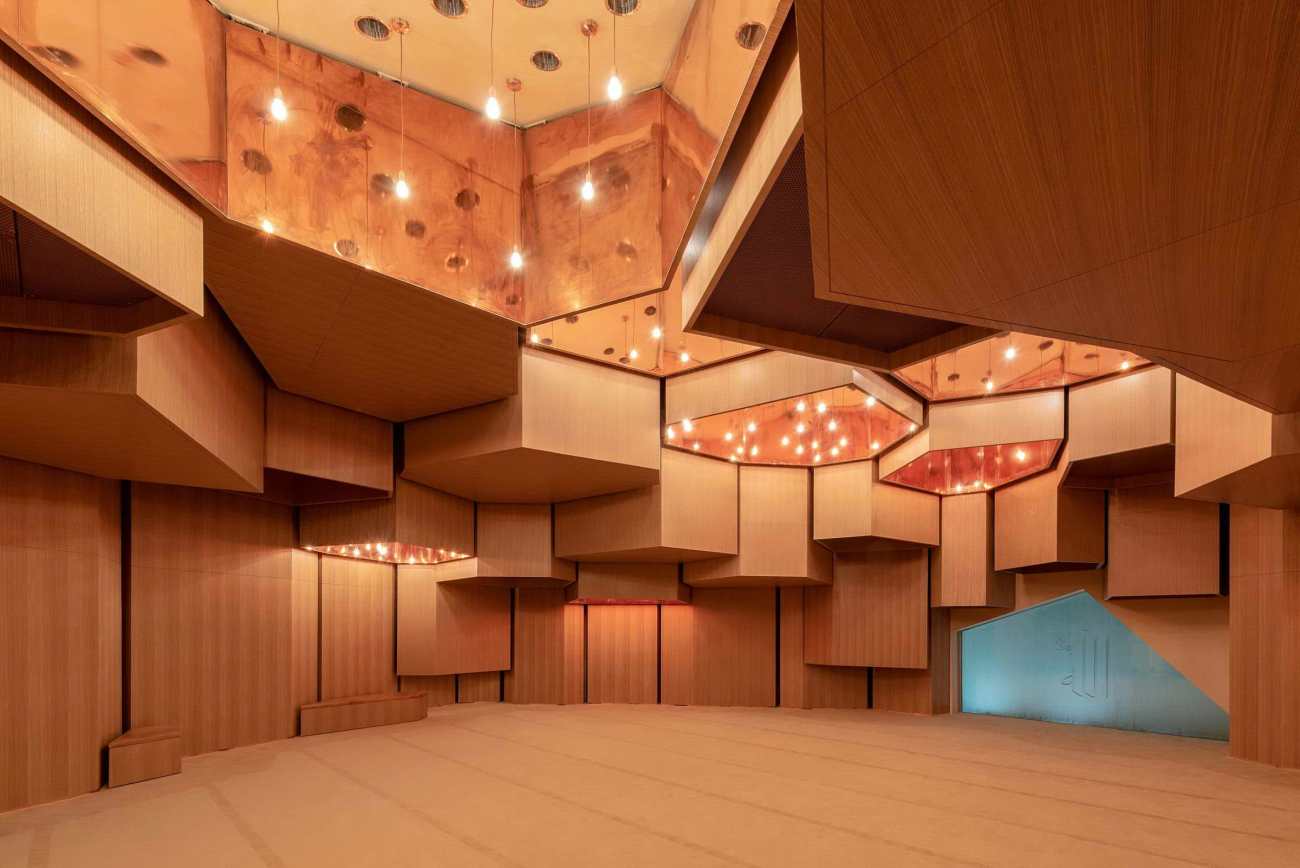| 公司: | CEBRA Architecture | 类型: | 景观 |
|---|---|---|---|
| 地区: | 阿联酋 | 标签: | 宗教空间 |
阿布扎比文化和旅游部(DCT)和CEBRA事务所已经完成了新的Al Musallah礼拜堂,作为阿布扎比市中心Qasr Al Hosn堡周围重要地点全面总体规划的一部分。自2015年赢得国际设计竞赛以来,丹麦工作室CEBRA建筑事务所与DCT一起,一直致力于Qasr Al Hosn总体规划的工作。今天,这个历史遗产地已被改造成一个充满活力的文化公园,包括Musallah--一个比清真寺略小的礼拜堂。项目被世界建筑节奖中被选为最佳宗教建筑。
The Department of Culture and Tourism Abu Dhabi (DCT) and CEBRA architecture have completed the new Musallah as part of the comprehensive masterplan for the prominent site surrounding the Qasr Al Hosn Fort in central Abu Dhabi. Together with DCT, Danish studio CEBRA architecture has been working intensively on the Qasr Al Hosn masterplan since winning the international design competition in 2015. Today, the historical heritage site has been transformed into a vibrant cultural park including the Musallah - a prayer hall slightly smaller than a mosque.
历史背景
在现代大都市阿布扎比的中心,坐落着这座城市最古老、最重要的建筑--哈森堡(Qasr Al Hosn)。这座重要的文化历史瑰宝城市最初建于18世纪,用于保护阿布扎比唯一的淡水井,后来成为皇家住所和政府建筑。在阿布扎比城市化之前,这个水井是旅行者从沙漠到达海岸的看到的第一个构筑物,这是一个从沙地上升起的地标,如同一座宏伟的雕塑,实际上催化了阿布扎比市的诞生。对Qasr Al Hosn的改造包括一个围绕堡垒的140.000平方米的文化公园和文化基金会,这是一个20世纪80年代的上市文化中心。这两座建筑共同占据了代表阿布扎比历史和现代遗产的街区。
A historical setting
In the centre of the modern metropolis Abu Dhabi lies the city’s oldest and most important building, the Qasr Al Hosn Fort. This important culture-historical gem was originally built in the 18th century to protect Abu Dhabi’s only freshwater well and later served as a royal residence and government building. Before the urbanization of Abu Dhabi island, the fort was the first thing travellers would see arriving to the coast from the desert - a landmark rising from the sands as a magnificent sculpture, literally constituting the birthplace of the city of Abu Dhabi. The transformation of the Qasr Al Hosn site consists of a 140.000 m2 cultural park surrounding the fort and the Cultural Foundation, a listed cultural centre from the 1980’s. Together, these two buildings occupy the block representing both historic and modern heritage of Abu Dhabi.
重新引入沿海沙漠景观
总体规划强调了这种二元性,将该地块斜向划分为两个对比鲜明的景观。一方面,堡垒周围是平原、柔软和开放的沙漠景观,将建筑恢复为沙地上的独立地标,就像现代城市迅速兴起之前那样。另一方面,文化基金会周围是一个铺设好的程序化区域,并加强了种植,将沙漠景观与现代城市网格结构相结合。
Reintroducing the coastal desert landscape The masterplan emphasizes this duality by dividing the site diagonally into two contrasting landscapes. On the one hand, a plain, soft and open desert landscape around the fort reinstating the building as a free-standing landmark on sand like it was before the modern city rapidly sprung up. On the other, a paved and programmed area with intensified planting around the Cultural Foundation, combining the desert landscape with the modern city grid structure.
总体规划通过一个多样化的公共城市空间将这两种类型的景观连接起来,其特点是裂缝的形成和不规则的几何形状,其灵感来自于阿布扎比周围沿海沙漠景观和盐滩的独特的泥浆裂缝模式。这些形状传达了自然沙地和城市路面之间的过渡,并作为整个场地的 "设计组件",形成了扎根于原始景观的强大和可扩展的叙述。
The masterplan connects the two types of landscapes through a diverse, public urban space that is characterized by formations of cracks and irregular geometric shapes inspired by the distinctive mud crack patterns of the coastal desert landscape and salt flats surrounding Abu Dhabi. These shapes communicate the transition between the natural sand and the urban pavement and serve as “design components” for the entire site forming a strong and scalable narrative rooted in the original landscape. The geometries intentionally land somewhere between building and landscape. Along the transitional zone, the landscape changes from horizontal planes to slanting surfaces and gradually grows into actual buildings, culminating with the Musallah. All components, from sitting bollards to building volumes, merge with the park to appear as natural landscape elements, leaving the Fort and the Cultural Foundation as the two main visual anchors.
礼拜堂
作为文化公园的一个重要元素,祈祷大厅位于场地的东北角,是一系列相互连接的小建筑,形成一个洞穴般的结构,被半推入一个大水景中。项目矗立在水中,在不使用墙壁的情况下创造了一个微妙的隐私屏障,这为祈祷提供了平静和隐蔽的空间,没有视觉干扰。同时,水被用作精神净化的象征,在内部功能的周围和之间流动。各个空间由玻璃管连接,在水面上架桥,当通过充满光线的通道从一个区域到另一个区域时,象征性地净化了心灵。
Al Musallah
As an important element of the cultural park, the prayer hall is located at the north-eastern corner of the site as a series of small interconnected buildings that form a cave-like structure pushed halfway into a large water feature. The Musallah stands in water to create a subtle privacy barrier without using walls, which provides calm and secluded spaces for prayer without visual disturbances. At the same time the water is used as a symbol of spiritual purification flowing around and in between the interior functions. The individual spaces are connected by glass tubes bridging over water, which symbolically purifies the mind when moving through the light-filled passages from one area to the next.
 |  |
每个体量都包含自己的功能,因此平面布局创造了两个镜像流,女性和男性崇拜者分别沿着一系列的空间前进,创造了一个沉浸式的精神体验,遵循祈祷的仪式。从公园的开放景观沿着 "岩石 "之间的狭窄通道行走,城市的噪音和喧嚣的生活慢慢消失,游客进入洞穴般的入口大厅,在那里你可以在祈祷前休息和交谈。这种体验和氛围参考了希拉山洞,先知穆罕默德在这里接受了他的第一次启示。从这里开始,人们前往洗浴空间,为祈祷做心理准备,最后到达大型祈祷厅。祈祷大厅的方向是朝向朝拜方向的,而在其中一个岩体上出现了带有铭文的混凝土浮雕,通过一个从外面隐藏起来的窗户可以看到。
Each volume contains its own function so that the plan layout creates two mirrored flows, where female and male worshippers respectively progress along a sequence of spaces that create an immersive spiritual experience, following the ritual for prayer. Walking from the open landscape of the park along the narrow passages between the “rocks”, the noise and bustling life of the city slowly fades away and visitors enter the cave-like entrance halls, where you can rest and talk before prayers. An experience and atmosphere that refer to the Cave of Hira, where Prophet Muhammed received his first revelation. From here, one proceeds to the ablution spaces for washing and mentally preparing for prayer and finally reaches the large prayer halls. The prayer halls are orientated in the qibla direction, while a concrete relief with inscriptions appears on one of the rock volumes, visible through a window that is concealed from the outside.
室内同样也迎合了景观和建筑的几何形状作为同样的泥浆裂缝图案的悬浮景观,其功能是天窗,小的圆形开口点缀在其他封闭的体积的天花板上。圆形孔洞让日光进入,并与悬挂的吊灯相结合。它们共同构成了抽象的星形,唤起人们对信仰以及贝都因人传统的观星导航的联想。入口大厅和沐浴空间含有混凝土天窗,而祈祷大厅的内部则用铜包覆,这创造了无尽的光线反射,象征着宇宙,并将天花板的细节连接到项目的整体方案中,就像一个分形图。而且,它说明了人类一直在仰望天空,怀疑和反思自己的存在。
The geometric shapes of the landscape and buildings are mirrored in the interior as a suspended landscape of the same mud crack pattern that functions as skylights with small circular openings punctuating the ceilings of the otherwise closed volumes. The circular holes let in daylight and are combined with suspended pendants. Together, they appear as abstract star formations that evoke associations to faith as well as to the Bedouins’ traditional star gazing for navigation. Whereas the entrance halls and ablution spaces contain concrete skylights, the insides in the prayer halls are clad with copper, which creates endless reflections of light symbolizing the cosmos and linking the ceiling detail back into the overall scheme of the project like a fractal. And, it illustrates how man has always looked up into the skies, wondering and reflecting on one’s own existence.
 |  |
Project: Al Musalla - The Mosque - Al Hosn Area
Location: United Arab Emirates - Abu Dhabi
Designer: Cebra
Project Year: 2019
Photos By: Mikkel Frost / Cebra
更新日期:2021-06-22 15:01:23
非常感谢 CEBRA Architecture 带来的精彩项目, 查阅更多Appreciations towards CEBRA Architecture for sharing wonderful work on hhlloo. Click to see more works!












